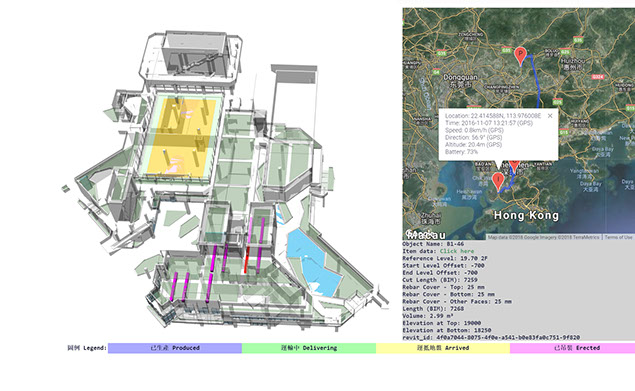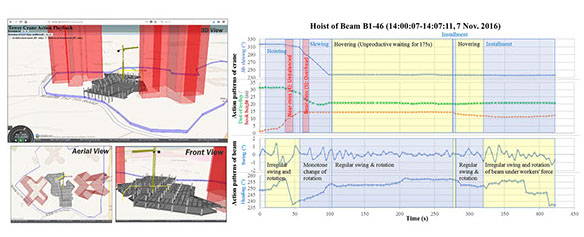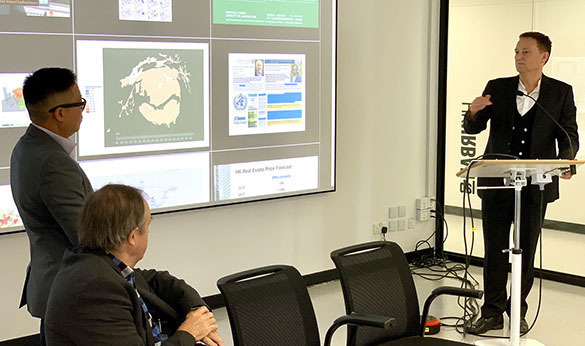Wake-up Call For Construction
The way the construction industry operates has changed little over the centuries, and major projects are regularly completed late and over-budget. Now, Building Information Modelling (BIM) is dragging the industry into the technology age, and HKU is at the forefront of the change.
The construction industry worldwide is going through a paradigm shift and, according to
Dr Wilson Lu Weisheng, Associate Professor in the Faculty of Architecture’s Department of
Real Estate and Construction, the change is long overdue.
Famously, or perhaps infamously, a Diagram of Productivity, put together by the McKinsey Global Institute, shows the construction industry having the lowest productivity gains of any industry over the past 20 years. By contrast, all other industries – including those such as agriculture which people view as unchanged and traditional – have improved productivity through the development and use of technology. The only odd one out is construction, which, according to Dr Lu, “basically still starts with a couple of joists!”
“The advent of Building Information Modelling (BIM) will change all that by using digitised drawing tools to work with 3D design files,” he said. “Under BIM regulations, before constructing an actual building you must construct a virtual building – a digital manifestation of the intended building that includes lifecycle information of all its components. This makes every aspect of the planned building visible, and enables architect, construction contractors, engineers, interior designers, facilities managers etc to sit together and consider the building before a single sod of earth has been turned.”
Using BIM avoids the need for repetitive two-dimensional shop drawings, which, Dr Lu pointed out “astoundingly are still often rendered in pencil on paper”. It will revolutionise the construction industry, and currently everybody is looking for experts.
The controversy over BIM comes from the lack of know-how and uncertainty within the industry – and of course a suspicion of anything new. This is where Dr Lu and his faculty colleagues Professor Steve Rowlinson and Ir Dr Llewellyn Tang, come in. Having done extensive research into research and development about BIM in Hong Kong, Mainland China and Australia, they have become the go-to people for an industry which is clamouring to know more about how to implement BIM and the regulations governing it.
Dr Lu’s area of expertise is BIM for public housing, in particular its logistics and supply chain management, while Professor Rowlinson concentrates on BIM for integrated project delivery and project procurement through VR (Virtual Reality) visualisation of the constructed facility, as well as the construction process.
Dr Tang’s focus is BIM certification using the BIM Level 2 suite from the UK and BS EN ISO 19650, with the first successful implementation and talent development for China’s largest asset management company the Wanda Commercial Management Group.
“The clear value of getting an international standard is not just helping an enterprise reduce costs with an internationally recognised documented management system, it also helps differentiate the architecture, engineering and construction (AEC) industry and to maximise the value of sharing best practice globally,” said Ir Dr Tang.
The team has sought and received HK$30 million in research funding for BIM in Hong Kong
and beyond, and they also played a role in allocating around a quarter of the Government’s HK$1-billion Construction Innovation and Technology Fund given to the construction industry.
The expected impact this breakthrough is having can be measured by the fact Chief Executive Carrie Lam mentioned BIM in her Policy Address in 2017, and for the first time last year it was mandated in Hong Kong law for any construction project valued at HK$30 million or more.
“At the moment, the resources are there, but the expertise is not,” said Dr Lu. “Major construction companies in the region are keen to adopt BIM. For example, the CEO of AECOM– which has 87,000 employees across the globe– recently said his company wants ‘100% exposure to BIM’. Hong Kong-based Gammon Construction, which has around 8,000 staff across Southeast Asia, wants the same.”
The demand for information stretches across the globe. Dr Lu was recently in Australia giving talks on BIM and the message he was receiving from many of the delegates there was ‘if you know anything about BIM we will hire you’, which he sees as good news for architecture, real estate and construction students looking to focus on this field.
BIM and GIS
Looking to the future, the possibilities for BIM go well beyond the construction stage. By linking BIM to GIS, for example, the digital models of buildings, roads and pedestrian networks can be synergised at an urban scale.
Professor Chris Webster, Dean of the Faculty of Architecture, commented: “It could form an urban digital platform to provide ‘all-round’ data relating to urban Hong Kong, from sky to ground, and from indoor to outdoor. Based on the platform, subsystems such as the building rooftop inventory subsystem, the 3D pedestrian network subsystem, or the planned urban morphometric subsystem will support studies and collaborations on urban planning and the overarching realm of ‘smart city’.
“Subsystems in the urban digital platform can also address a series of socioeconomic problems concerning Hong Kong’s unique construction needs,” he continued. “For example, the building rooftop inventory subsystem contains information-rich elements that could support heat island effect analyses in densely populated areas and investigations on unauthorised building works; the 3D pedestrian network subsystem allows the modelling of pedestrian routes across the city for navigation, pedestrian footfall analysis and many other uses.”
Pioneered in the US at institutions such as Stanford and Georgia Tech, BIM has already been adopted in countries such as the UK, Singapore and recently Hong Kong. “Now other countries are rushing to keep up,” concluded Dr Lu. “BIM will revolutionise the construction industry and we at HKU want to be a driving force in that revolution.”

![]() Under BIM regulations, before constructing an actual building you must construct a virtual building – a digital manifestation of the intended building that includes lifecycle information of all its components. This makes every aspect of the planned building visible.
Under BIM regulations, before constructing an actual building you must construct a virtual building – a digital manifestation of the intended building that includes lifecycle information of all its components. This makes every aspect of the planned building visible. ![]()
Dr Wilson Lu Weisheng

Back
Smart core technologies and BIM for construction safety management in Hong Kong.
Core members of the HKU BIM team – (from left to right) Dr Wilson Lu, Professor Steve Rowlinson and
Professor Chris Webster.


Auto-ID and BIM for logistics and supply chain management for public housing in Hong Kong.
Home
May 2019
Volume 20
No. 2

Research
